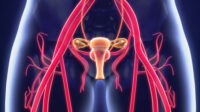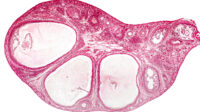Passing the 2016 ABOG OB/GYN board exam may feel like a daunting task, given the multitude of topics you are required to know in Gynecology, Obstetrics, Primary Care and more.
But not to worry – answering sample questions can be a great way to help you practice for the exam. See how you stack up with the two questions below from the BoardVitals OB/GYN Board Review Question Bank.
Question 1
A 54-year-old woman is now postoperative day 7 after cytoreductive surgery for high-grade serous carcinoma of the ovary. Her cytoreductive surgery included a total abdominal hysterectomy, bilateral salpingo-oophorectomy, omentectomy, small bowel resection and a splenectomy. At the conclusion of surgery, there was no remaining visible disease. Her postoperative course has been uneventful and she is to be discharged home today. To decrease the risk of postsplenectomy sepsis, she should receive vaccinations directed towards the following pathogens:
A.) Streptococcus pneumoniae, Haemophilis influenzae type B and Neisseria meningitides
B.) Neisseria gonorrhea, Treponema pallidum, Haemophilus ducreyi
C.) Epstein-Barr virus and cytomegalovirus
D.) Human papillomavirus (types 16 and 18)
Answer:
A.) Streptococcus pneumoniae, Haemophilis influenzae type B and Neisseria meningitides
Explanation
Answer: A. Loss of functional splenic tissue increases the risk of infection with encapsulated organisms such as Streptococcus pneumoniae, Haemophilis influenzae type B and Neisseria meningitidis. Postsplenectomy infection may result in overwhelming postsplenectomy sepsis. While the incidence of overwhelming postsplenectomy sepsis is low (0.05% to 2%) [1], mortality is significant and has been reported to be as high as 50% [2,3]. Non-elective splenectomy patients should be vaccinated against Streptococcus pneumoniae, Haemophilis influenzae type B and Neisseria meningitidis on or after postoperative day 14. B. The listed pathogens are sexually-transmitted diseases and not causative agents of postsplenectomy sepsis. The most appropriate answer is A. C. The listed viruses are not encapsulated organisms and not causative agents of postsplenectomy sepsis. The most appropriate answer is A. D. The listed virus is the causative agent for cervical dysplasia and cervical cancer, not postsplenectomy sepsis. The most appropriate answer is A. Summary: After non-elective splenectomy, patients should be vaccinated against encapsulated organisms (Streptococcus pneumoniae, Haemophilis influenzae type B and Neisseria meningitidis) to decrease the risk of postsplenectomy sepsis.
Reference: 1) Shatz DV. Vaccination practices among North American trauma surgeons in splenectomy for trauma. J Trauma 2002; 53:950-956. 2) Dickerman JD. Traumatic asplenia in adults. Arch Surg 1981; 116:361-363. 3) Davidson RN, Wall RA. Prevention and management of infections in patients without a spleen. Clin Microbial Infect 2001; 7:657-60.
Question 2
A 25 year old G1PO woman at 37 weeks gestation with a history of a spinal cord transaction at T8 level presents to the obstetrical office. Her prenatal course has been unremarkable, with a normal fetal growth and development ultrasound at 32 weeks. She is concerned about her upcoming labor course. Which of the following is the most reliable method of preventing autonomic dysreflexia for this patient?
A.) Spinal or epidural anesthesia extending to the T10 level
B.) Spinal or epidural anesthesia extending to the T9 level
C.) General anesthesia during labor
D.) General anesthesia plus use of antihypertensive medications during labor
E.) Scheduled cesarean delivery at 39 weeks gestation
Answer
A.) Spinal or epidural anesthesia extending to the T10 level
Explanation
Answer: (A) Spinal or epidural anesthesia extending to the T10 level. Explanation: spinal or epidural anesthesia extending to the T10 level. Anesthesia above and beyond the level of transaction will provide the best anesthesia. (B) T9 might be too low and the lesion not be covered. (C) general anesthesia is not indicated unless a spinal/epidural cannot be placed. (D) addition of antihypertensive agents are recommended if autonomic dysreflexia occurs but not planned with general anesthesia. (E) a scheduled cesarean delivery should be done for obstetrical reasons only.
Reference
Williams Gynecology, 24th edition, p. 1174 and ACOG Committee Opinion Number 275
Looking for more review questions? Sign up for a free trial of BoardVitals OB/GYN Question Bank. Good luck with your OBGYN Board Exam!




